About a quarter ago, I wrote about the “collectivist” trading environment we seem to find ourselves in:
…everything has turned into a collectively owned, collectively crowded trade — something I’m simply not comfortable with trading myself. Everything turns into a liquidity suck of sorts — historically, it would be called “sector rotation” when big fundamental flows moved from, say, telecoms to energy. Nowadays, this happens hour-to-hour…
The regime change is so fast that “sector rotation” from BTC on an ETF thesis to Solana shitcoins to wherever’s next happens inter-weekly and also has secondary pumps before the money shifts to the next trend.
We know it’s all nonsense. Market capitalization, future cash flows, P/E ratios, Graham, “value”, are coping rationale for “intelligent investors” who don’t understand that valuation has not, nor has it ever been, a short thesis (ML 7, 12/09/20):
“Valuation is not a short thesis” is one of my all time favorite sayings about markets, which ties back into the “theoretical valuation” discussion from yesterday: as long as speculators are still biased towards the upside, the price of a stock will continue to be bid up. As such, shorting a stock requires both the valuation to be high and a catalyst to bring the stock price back to reality - in essence, betting on the downside requires being correct both on the price and the timing.
The best way to think about theoretical pricing (“valuation”) is that, you can have any sort of proprietary valuation you want, but the only thing that matters is whether you can get filled or not, whether it is an M&A deal or a call option. What we realize is that, beyond all the waxing poetic about the “philosophy of money” and “postmodern markets”, the only thing that matters anymore is “number go up”. You can call it (3,3), Marxism, “everyone dependent on the same trade”, or whatever you want, but the core point is that nobody values bid-side liquidity the same as ask-side liquidity at the moment, so all you can do is stay long with everyone else. Unless this pattern of behavior cohesively breaks — and there’s no “one way” to do this — you will always get a rebound after, say, an NVDA selloff or a temporary dip in housing prices.
I went on to mention that one of the only catalysts I saw for this changing was the AI bubble (and therefore, NVDA ER beats) popping:
AI actually does create a cross-industry, revolutionary application (<3 years is my timeline) or if it doesn’t (more likely imo), the entire tech sector’s air lets out. The sector inflows have been so congregated into existing tech and purely speculative AGI plays that, without some sort of benefit across industries, this seems like incinerated capital and compute (which will spook the “sector rotation” class.) I did note that MSFT seemed very skittish when it came to OpenAI based off their investment structure (ML 79, 1/11/23):
While Microsoft’s investment is clearly an equity investment bullish on the overall ability of OpenAI to facilitate the production of a minimum viable product, it’s interesting to me that the proposed terms highlight a right to 75% of OpenAI’s profits — it’s kind of like having the ability to exercise an option to cash out rather than essentially being required to plunge any revenue into reinvestment to potentially gain a positive ROI as you’d normally expect from a venture equity position. To me, this “fail-safe” implies a certain level of skittishness that OpenAI will ever produce anything of real go-to-market value.
I will say, I feel like I was ultra on the nose with that OpenAI take, given all the stuff that’s been going on.
Look, we know NVDA is going to “beat” ER. They’re doing revenue washing that I haven’t seen since the likes of Enron (ZIRP was more about pre-revenue plays, to use the infamous Silicon Valley line).
As a professed Enron fanboy (I credit them for inventing postmodern finance well before ZIRP, and got corrupted by materialism instead of thanklessly writing a blog like true apostles do)
Accordingly, here’s what I wrote about NVDA ER in February (copied for readability):
Thoughts on NVDA ER: Everyone needs this stock to go up. Earnings vol is fundamental flows so the reaction is unpredictable, but no matter what happens the direction is up long term. Directional calendars/diagonals along monthlies are your friend here.
I never traded ER much other than for fun, but the flow shakeout is important bc it’s when the quarterly snapshot funds move. Most important abt the reaction is gauging whether markets will reflexively bid on an ER drop (hence the % surprise mattering)
I wrote this post in Dec 22 (ML 72). If you had tried to buy the META dip, you would have gotten crushed for a year. Why? Bc the fundamental bid hadn’t bought in that Zuck was the right long term plan and he cannot be removed:
Prices don’t drop due to sellers “overwhelming” buyers, but rather due to lack of bid. If you are long, you can’t make a return unless bidding is strong. In META’s case, all the big investors who would normally come in and support the price and add to their investment aren’t because of the uncertainty of future cash flows and the unknown return on the cash Zuckerberg is currently lighting on fire to produce the metaverse. They have no certainty in their models, so they won’t bid.
Thus, it’s not really surprising that I’ve been rehashing the same thing. Everyone needs this stock to beat.
Hence, when I was talking about the Fed yammering and why I didn’t really care last week, it’s precisely because I know that this is what everyone is looking to in stock-land. NVDA ER is the “Fed Day”. I am reminded of the “Scary Jerry” trope I came up with ages ago (from Dec, 2020):
There are a few types of large traders, but the ones I commonly tend to focus on the most are either “passive” index investors, the people who outsource all decisions to S&P’s board, or, I don’t know, a Council of Six, and fund managers, who tend to buy and sell when things trend up or down or according to their strategy and prospectus (until that prospectus is totally ignored). A particular form of active manager is the “Scary Jerry”, where, upon any uncertainty, they are smashing the ask and crossing spreads to get out of a position and driving prices arbitrarily lower than they should purely through the size of their trade being larger than the market can support at current price levels.
Why I told everyone that I was exiting high beta longs for Monday and Tuesday is precisely because Scary Jerry is the one who actually reacts to the ER, and isn’t in on the game with everyone else. Scary Jerry slams the tape after hours because the initial candle is red. Indeed, why high beta names are getting crushed this week is because everyone is sitting on a fair bit of profit on stuff like ASTS and figures that if NVDA misses, high beta bid is gone for the week. So price action follows that with volume returning from the summer, the book is going to be impacted without “true” bid, indicating the direction is downwards (as I mentioned a couple paragraphs prior.)
Scary Jerry is the one sitting at the pub, excited to tweet about the instant the numbers drop and overreact to whatever their call options might project the open at. (Accordingly, virtually every financial media employee is a textbook Scary Jerry.)
The golden rule of trading is to not bet against the size, and all of the size is all in on AI, NVDA, and nobody wants to find out what happens if it doesn’t work any more than people want to figure out how we’re going to pay off the national debt. That’s the thing about (3,3), if enough people want to kick the can down the road, you can do so endlessly. Betting on the big short is missing the big picture that the precise timeline is unknowable unless you have an idea of what the catalyst is. I can promise you it won’t be earnings numbers this time around, I think it would take the form of Microsoft admitting the OpenAI failed, either tacitly or explicitly, and ripping the IP from the “nonprofit” structure and internalizing it rather than continuing to open the checkbook for them. After the rest of the week plays out and the Scary Jerries get tossed overboard, I will update my priors and outlook going forward.
If you enjoyed this post, please consider forwarding the email or sharing a link.


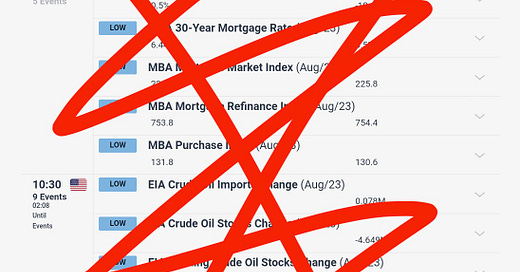



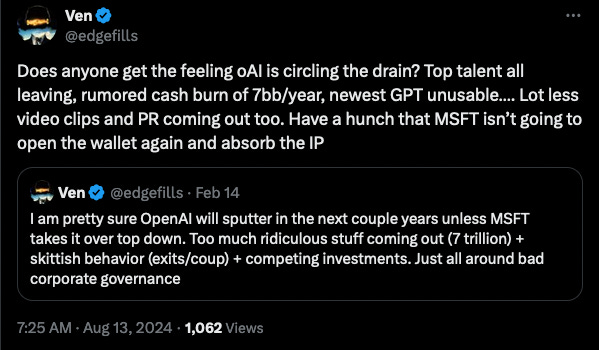
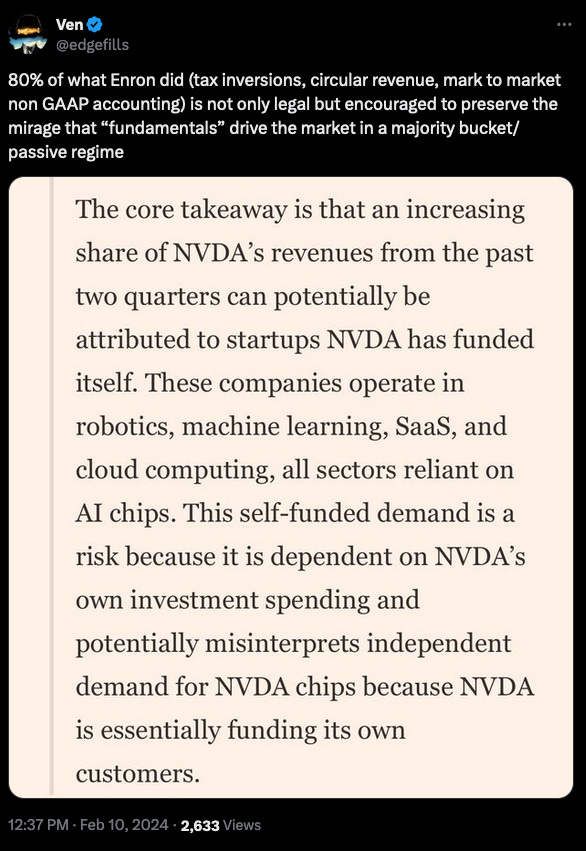
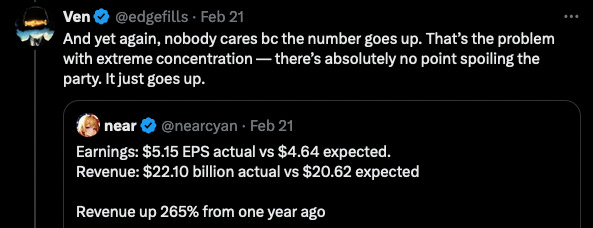
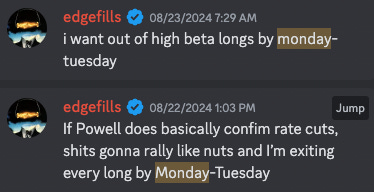
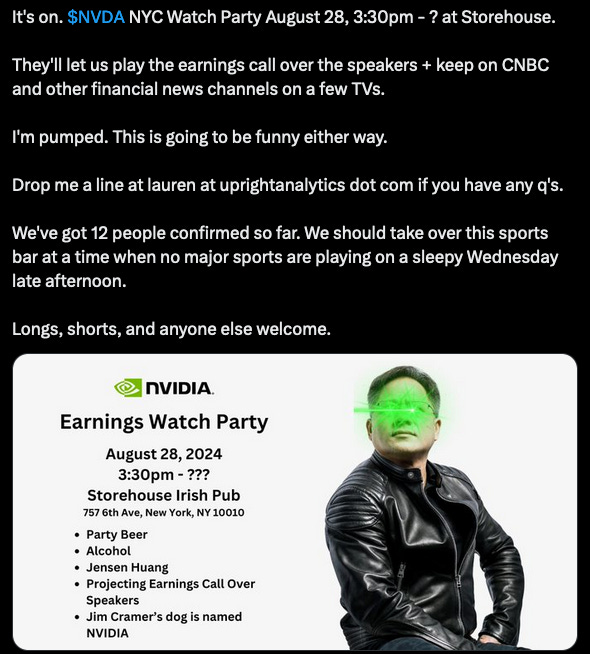
What does (3,3) mean here? Thanks. 🙏🏼